A gallery of meow-sterpieces
Paintings become that much better with a pudgy tabby cat added into the mix, dont you agree?

All photos courtesy of Svetlana Petrova & Zarathustra the Cat / FatCatArt.com What is art? It's an age-old question humans often ask themselves. Is it a display of skill? An expression of thought or feeling? An imitation of beauty? Or is it something involving a ginger cat named after a comedic philosophical novel by Friedrich Nietzsche?
Enter Fat Cat Art.
Artist and curator Svetlana Petrova created the Fat Cat Art project alongside her “co-author” and muse-or mews, if you will-Zarathustra, a 9-year-old tabby cat who lives with her in St. Petersburg, Russia. “Zarathustra is known for his ability to improve famous paintings,” Petrova states in an online post. “I am just a humble assistant to His Furry Majesty, who kindly allows me to use all my painting, photography and Photoshop skills to insert his precious images into masterpieces of renowned artists of the past.”
From medieval depictions to modern works, Zarathustra has found himself immortalized within some of the most well-known works of art around the world. Let's travel movement through movement. Click through each page or select the era you'd like to study below.
Renaissance | Baroque | Impressionism | Symbolism | Surrealism
Renaissance
Leonardo da Vinci, “Meow-na Lisa”

Perhaps the most famous painting portrait in the world, the poplar-panel oil painting by Leonardo da Vinci has gathered speculation from critic and onlooker alike. Much about the depiction of the unnamed subject is up to interpretation, including her famously elusive smile.
Little do these experts know, the smile can easily be explained away when Zarathustra is added to the photo. Who wouldn't smirk like that with a tabby cat taking up residency in your lap?
Michelangelo, “The Creation of Cat-am”
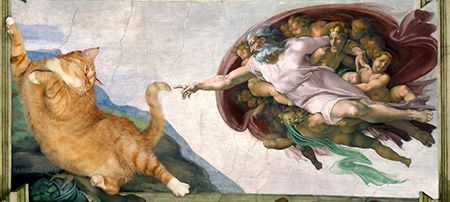
This fresco painting belongs on the ceiling of the Sistine Chapel, and illustrates the scene of Adam, the first man, receiving the gift of life. The near-touching hands Michelangelo depicted have become iconic, making this work of art one of the most replicated religious paintings of all time.
What's less well-known (and really shouldn't be, TBH) is how cats came to be. Luckily, Zarathustra could recreate the Biblical creation of Cat-am, the first cat.
Baroque
Rembrandt Harmenszoon van Rijn, “The Night Watch (Company of Frans Banning Cocq and the Cat)”
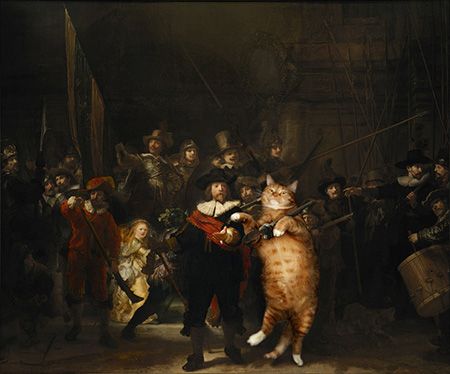
Famous for his play with shadow and light (tenebrism, for you art nerds out there), Rembrandt was commissioned by Captain Banning Cocq and the other members of his civic militia to hang in the banquet hall of the newly built Musketeers' Meeting Hall in Amsterdam. Many speculate that it was meant to impress the French queen, Marie de Medici, when she visited in 1638.
What makes the painting more impressive, other than its colossal size, is the captain's righthand cat, Zarathustra. We think he's carrying a musket.
Johannes Vermeer, “Girl with a Pearl Earring (and Ginger Cat)”
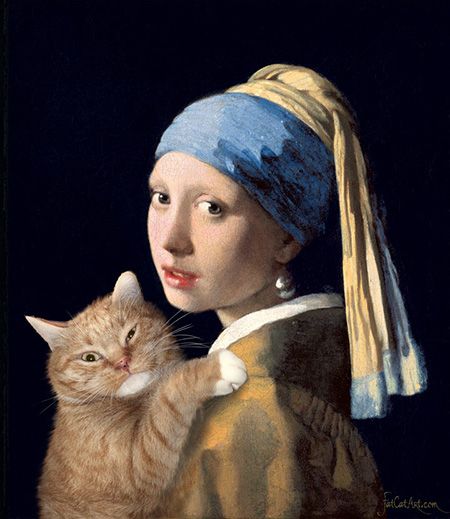
This oil painting on canvas is known as a “tronie,” or a painting of someone's head that isn't meant to be a portrait. For over a decade, Vermeer's depiction of this girl in a headscarf and jewelry has been well-known as the most beautiful painting in the Netherlands, selected by the Dutch public.
The earring in this photo has been debated-skeptics say that the large piece of jewelry is more likely to be polished tin than a pearl that large. What skeptics can all agree on is how badly Zarathustra wants to bat the earring like a low-hanging tree ornament.
Impressionism, Post-Impressionism
Vincent van Gogh, “Vase with Irises and the Cat”
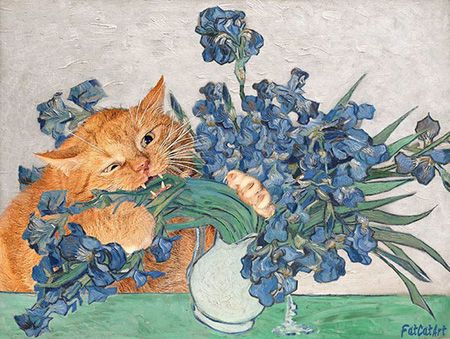
Known for his expressive and colorful paintings, van Gogh is one of the major influences to lead the way into modern art. In this still-life painting, van Gogh depicts purple irises against a complimentary pink background that has since faded to white. It is one of a series he painted during his stay at Saint-Paul Asylum, a mental hospital in Saint-Rémy-de-Provence, France, during the last month of his yearlong stay.
“Unfortunately,” Zarathustra writes on his website, “beautiful flowers are toxic for cats. Better to not eat them, but just drop the vase from the table-your human will have a lot of fun!”
Claude Monet, “Water Lilies and a Wet Cat”
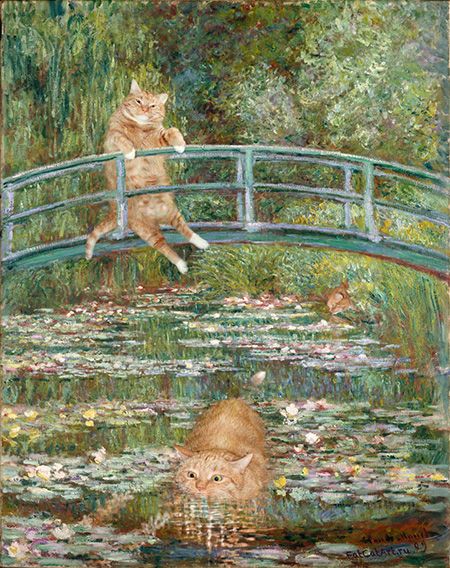
Monet is possibly most commonly recognized for his series of more than 200 oil paintings of water lilies. During the last 30 years of his life, they were the main focus of his artistic production-many were even painted while he suffered from cataracts. You can find his series spread throughout the world, from Kansas City to Tokyo.
Only one, however, is graced with the presence of Zarathustra. In this particular work, you can see him in different poses throughout (look closely, there's a third depiction of the tabby cat).
Symbolism
Gustav Klimt, “The Fuzzy Kiss”
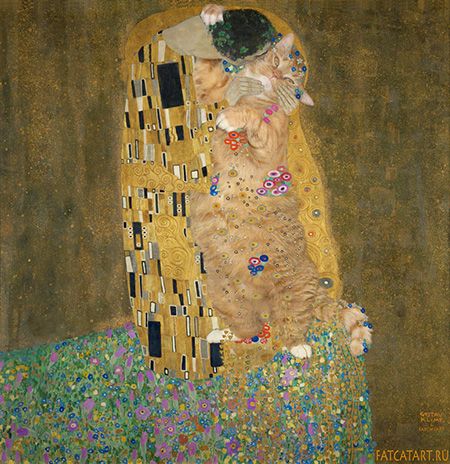
The tell-tale use of gold leaf in this piece has Klimt written (er-painted?) all over it. The depiction of a couple passionately embracing is widely considered a masterpiece of the early modern period. In many of his works, this one included, he brings forth themes of romance and intimacy. Regarding his controversial art, he inscribed on the reverse of the 1899 Nuda Veritas, “If you cannot please everyone with your deeds and your art, please a few.”
As a cat, Zarathustra doesn't much care for pleasing anyone as long as he's happy. “Yes, we can tolerate a lot from our [human], even his weird way of showing affection,” he writes on his website. “A kiss? Really, what is that?”
Frida Kahlo,“Two Fridas, One Cat”
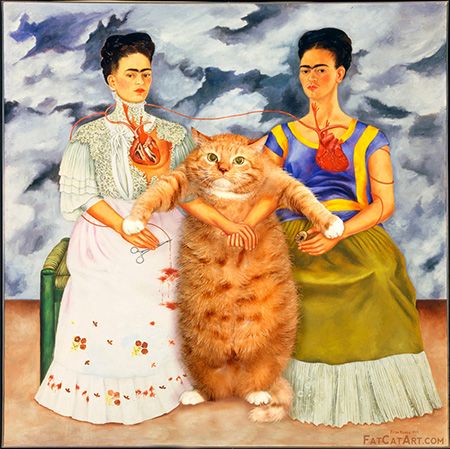
As her first large-scale work, Kahlo depicts two versions of herself seated together-one wearing a European-style dress, the other wearing a traditional Tehuana. Through her art, Kahlo tended to explore themes in Mexican society like identity, postcolonialism, gender, class and race, and this work of hers is no different-it's also one of her most popular.
While many suspect she painted this to capture the loss she felt for her recently divorced husband, Diego Rivera, it's actually to depict the pain of not being able to duplicate yourself to pet Zarathustra with more than two hands.
Surrealism
Rene Magritte, "The Treachery of Images. This is not a cat!"
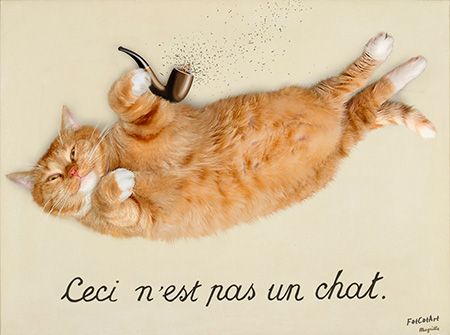
With this oil painting, Magritte created one of his most famous thought-provoking pieces. The Belgian painter is well known for challenging those who view his art and their preconceived notions of reality. “The famous pipe,” he said on the matter. “How people reproached me for it! And yet, could you stuff my pipe? No, it's just a representation, is it not? So if I had written on my picture, ‘This is a pipe,' I'd have been lying!”
Likewise, the painting of Zarathustra with the pipe is just as intangible. Though it may look like a fluffy tabby cat, it's definitely just a painting. You can pet your computer screen anyway, we won't judge.
Salvador Dali, "The Purr-sistence of Meow-mory"
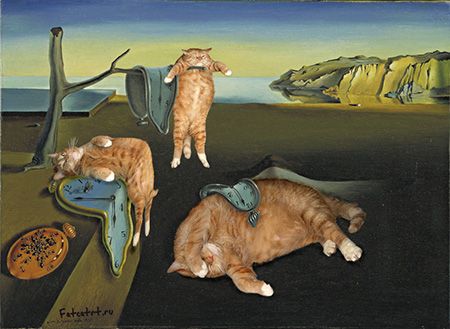
Perhaps the most recognizable work of Dali-if not the most recognizable of surrealist works-Dali's oil painting is often thought to be his interpretation of Albert Einstein's theory of special relativity. When prompted by physical chemist and Nobel laureate Ilya Prigogine, however, Dali stated that the melting watches were, in fact, inspired by cheese melting in the sun.
Though cats don't quite melt like cheese, they can give the appearance of it. Zarathustra shows off several positions often seen by those who study cat physics.